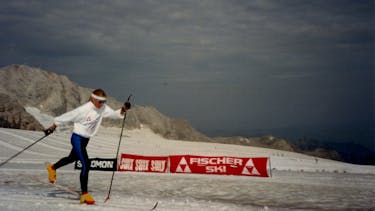
Dorcas Denhartog—who now goes by the surname Wonsavage—began cross country skiing when she was a senior in high school. Her dad splurged and bought her a pair of Fischer RCS skis, a relatively early model of the Austrian manufacturer’s flagship racing ski. For decades, however, the RCS was one of the top skis on the market for both skate and classic, and they set the stage for Wonsavage’s future career. During her undergraduate years, Wonsavage walked onto the Middlebury College ski team after being recruited to the school on a field hockey scholarship. Eventually, she competed at the 1988 Winter Olympic Games in Calgary, Alberta.
“We were amateurs in the truest sense,” Wonsavage explains. “It was definitely hand to mouth, if you didn’t make the team from one year to the next it was very difficult to consider moving on to keep racing the following year.” Since attending her first Junior Nationals at Lake Placid Fischer had been her primary equipment sponsor, providing her with free skis—RCS’s to be specific.

When asked what she sees as some of the biggest changes between when she was racing internationally and the achievements of today’s top athletes, she points out the huge difference in the coaching staff. The Nordic ski staff in the late ’80s and early ’90s usually had a head coach and maybe one or two volunteers. They lacked all the medical oversight, nutritional experts, and exercise physiologists that the team benefits from now.
Wonsavage’s recollection of the developments seen in cross country racing tracks well with the development of the RCS line. This includes the prominence of skate skiing, which, at the beginning of her career, still wasn’t universally included on the collegiate circuit. Fischer helped foster the growth of the discipline by investing in making shorter skis that skated better. The RCS has undergone color changes, beginning with a red and white scheme and moving toward Fischer yellow. And throughout this time, these skis have seen dramatic technological changes, too, which has kept them on race podiums at all levels of competition.



